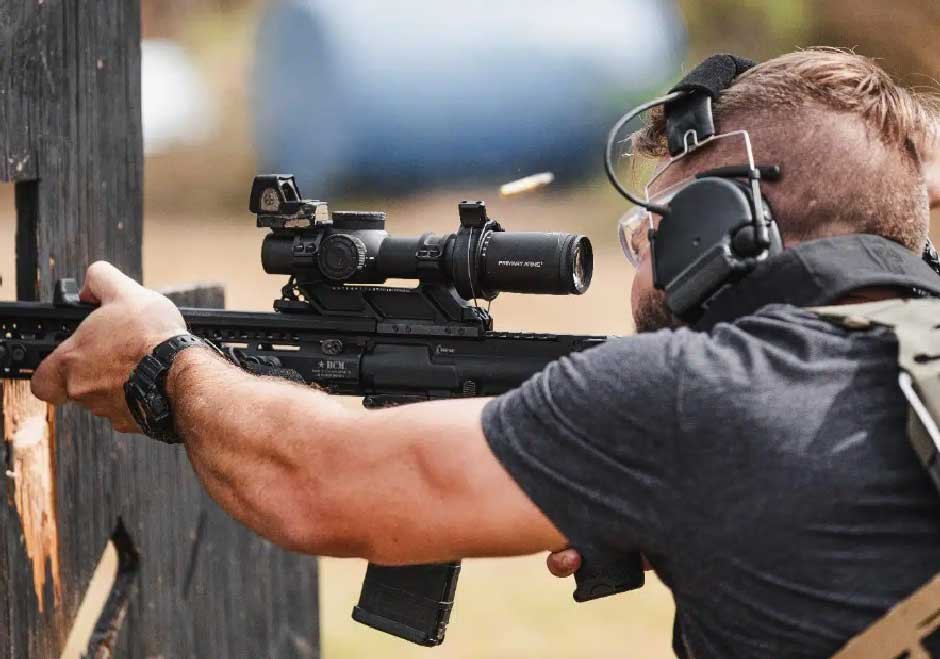Skip to the good bit
ToggleIn the constantly evolving world of tactical shooting, the choice of optics can significantly impact performance and precision. Among the most debated topics in this arena is the comparison between LPVO vs fixed power scopes. Each has its distinct strengths, and selecting the right one depends on your mission requirements, engagement distances, and personal shooting style.
Whether you’re operating in a dynamic tactical environment or looking to sharpen your long-range accuracy, understanding the differences between fixed vs variable magnification scopes is crucial. In this guide, we break down the pros and cons of LPVO optics versus fixed power scopes, compare LPVO vs prism scope, and examine how LPVO for precision shooting stacks up.
What Is an LPVO Scope?
LPVO stands for Low Power Variable Optic, a scope designed to offer a wide range of magnification—usually from 1x up to 4x, 6x, 8x, or even 10x. This makes LPVO optics highly versatile and suitable for both close-quarters combat and mid-range engagements.
Advantages of LPVO Optics
- Versatility: Use 1x magnification for quick target acquisition like a red dot, and dial up for longer-range shots.
- Enhanced Situational Awareness: At 1x, you can shoot with both eyes open.
- Reticle Functionality: Many LPVOs come with illuminated reticles, BDC (bullet drop compensation) marks, and ranging features.
- Ideal for Hybrid Engagements: Perfect for users who transition between CQB and 300+ yard shots.
What Is a Fixed Power Scope?
A fixed power scope has a single magnification level, such as 3x, 4x, or 10x, and does not allow the shooter to adjust magnification. These optics are valued for their simplicity, durability, and consistent image quality.
Advantages of Fixed Power Scopes
- Simplicity and Reliability: Fewer moving parts mean less risk of failure.
- Lightweight Design: Generally lighter and more compact than LPVOs.
- Excellent Optical Clarity: With a fixed magnification, the lens and reticle can be optimized for peak clarity and brightness.
- Faster Target Transition at Known Distances: Great for static shooting positions or patrol rifles.
LPVO vs Fixed Power: Direct Comparison
Let’s take a closer look at the LPVO vs fixed power debate across various tactical shooting aspects:
| Category | LPVO Optics | Fixed Power Scopes |
| Magnification | Variable (1x to 4/6/8/10x) | Single (e.g., 3x or 4x) |
| Versatility | Highly adaptable for varying ranges | Best for specific use cases |
| Weight | Heavier due to added glass and mechanisms | Generally lighter |
| Cost | Typically more expensive | More affordable |
| Learning Curve | Requires practice to transition between ranges | Very easy to use |
| Precision Shooting | Great for hybrid roles and long-distance holdovers | Excellent at set distance, less versatile |
Fixed vs Variable Magnification: Which Is Better?
When choosing between fixed vs variable magnification, your intended application plays a major role.
Choose LPVO if you need:
- Engagement flexibility from 5 yards to 300+ yards.
- A dual-purpose optic for both CQB and mid-range roles.
- The ability to dial magnification for reconnaissance or target ID.
Choose Fixed Power if you need:
- A simple, rugged optic for rapid engagements at a fixed distance.
- Lightweight and compact gear for mobile operations.
- Budget-friendly optics with fewer failure points.
In general, LPVO optics are better for shooters who need to operate in diverse environments, while fixed scopes suit users with consistent shooting parameters.
LPVO vs Prism Scope: Another Common Comparison
Some users also compare LPVO vs prism scope, especially when considering fixed power optics.
Prism Scopes Overview:
Prism scopes are compact optics that use a prism to focus the image, offering fixed magnification (usually 1x to 5x), etched reticles, and bright visuals. They are often seen as a hybrid between red dots and fixed scopes.
LPVO vs Prism Scope: Key Differences
| Feature | LPVO | Prism Scope |
| Magnification | Variable (1x-10x) | Fixed (1x to 5x) |
| Eye Relief | Usually longer | Can be shorter |
| Reticle Type | Etched + illuminated | Etched + often illuminated |
| Weight | Heavier | More compact |
| Price Range | Higher | Moderate to budget |
If you’re torn between LPVO vs prism scope, think about your operating conditions. LPVOs offer superior flexibility, while prism scopes are great for shorter engagements and low-profile rifles.
Is LPVO Good for Precision Shooting?
Absolutely. While not a traditional precision optic like a high-magnification rifle scope, LPVO for precision shooting excels in fast-paced, practical shooting scenarios such as:
- 3-Gun Competitions: Quick transitions and medium-range targets.
- DMR Roles (Designated Marksman Rifle): Engaging targets up to 600 yards.
- Tactical Field Use: Rapid target ID and accurate engagement under stress.
The BDC reticles, MOA/MIL holdovers, and higher magnification options (up to 10x) make LPVO optics highly capable for precision shooting in dynamic environments.
Use Case Scenarios: LPVO vs Fixed Power
To further clarify your choice, here’s how each optic performs in real-world tactical scenarios:
Urban CQB Operations
- Best Choice: LPVO
- Use 1x for rapid target acquisition and dial up when needed.
Mountain/Forest Patrol
- Best Choice: LPVO or Fixed 4x
- LPVO for recon versatility; fixed 4x for lightweight carry and simplicity.
Long-Range Recon or DMR Role
- Best Choice: LPVO (1-8x/1-10x)
- Offers the best mix of close and extended-range performance.
Budget Patrol Rifle Setup
- Best Choice: Fixed Power Scope or Prism
- Durable, affordable, and fast for engagement under 300 yards.
Pros and Cons Summary
LPVO Pros
- Adjustable magnification
- Dual-role capability
- Great for both CQB and precision
LPVO Cons
- Heavier and costlier
- Slight learning curve for transitions
- More parts = more potential failure
Fixed Power Pros
- Lightweight and compact
- Rugged and simple
- Cost-effective
Fixed Power Cons
- Limited flexibility
- Less effective at varying ranges
- Lower versatility in dynamic roles
Final Verdict: Which One Should You Choose?
There’s no one-size-fits-all answer in the LPVO vs fixed power debate. Your personal shooting style, mission profile, and equipment preferences will determine the best optic for you.
- If you want maximum versatility, adaptability, and the ability to handle both CQB and precision shooting, go with an LPVO optic.
- If you prefer simplicity, low weight, and fast acquisition at a known distance, a fixed power scope might be your best choice.
For many tactical shooters, investing in a high-quality LPVO is worth the additional cost and weight, especially given how modern models offer exceptional performance and rugged reliability.
Explore the Latest in LPVO Optics
Whether you’re upgrading your tactical setup or building a new rifle from scratch, the optic you choose matters. Explore the latest generation of LPVO optics and discover how variable magnification can revolutionize your shooting performance.
If you’re still comparing fixed vs variable magnification or want to understand how LPVO vs prism scopes differ, consider visiting a local range and testing them firsthand.
Remember — the best optic is the one that works for your mission, your rifle, and your goals.







